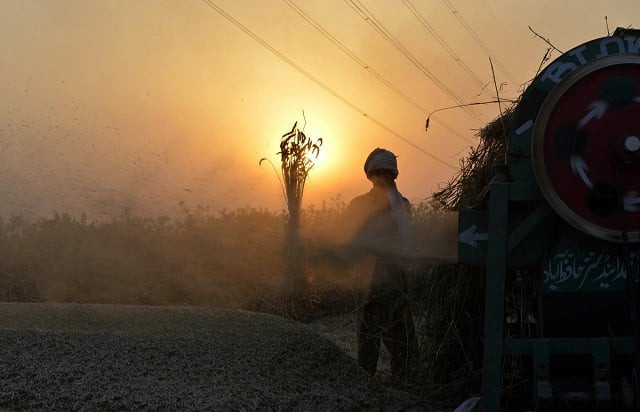Agriculture needs sharper focus
Country has failed to exploit export potential of sector due to flawed policymaking

Despite having a strong resource base, Pakistan has been failing to show a continuous upward growth trend in its agriculture sector for the past few years.
Data released by the Pakistan Bureau of Statistics (PBS) reveals a topsy-turvy growth of agriculture sector in the last six financial years—0.2% in FY16, 2.2% in FY17, 4.0% in FY18, 0.6% in FY19, 2.67% in FY20 and 2.77% in FY21.
Agriculture sector provides employment to 38.5% of our labour force along with adding 19.2% to the total GDP. Such an important sector of the economy obviously requires enhanced attention of the policymakers. But unfortunately, policy focus on agriculture has remained missing for years. If we look at agricultural development budget, for example, we find it disappointingly low—9% of the total development outlay for FY21. Compare this low percentage to agriculture’s 19.2% contribution to GDP. Does it make any sense?
In Pakistan’s agriculture, livestock has a mammoth 60.1% share followed by major and minor crops at 34.2%. Fishing and forestry constitute a little over 5% of the entire agriculture sector. An exceptional export potential lies in all these sub-sectors particularly in livestock, crops and fishery. But we have failed to exploit this potential due to flawed policymaking and ineffective implementation of policy measures.
The reasons for low and inconsistent growth of agriculture are both domestic and international. Among the significant problems at the domestic front are traditional methods of cultivation, uncertain irrigation, improper soil management, expensive fertilisers, pests and plant diseases, unavailability of high yield genetically transformed seeds, lack of credit facility for purchasing modern technologies, under investment in agriculture research and training and occasional locust attacks.
In international markets, we face marketing and branding problems of our products. We have long been exporting raw agricultural produce like cereals and do not bother to focus on producing value-added products. World class branding remains missing and even for non-branded raw agricultural produce, the existing marketing infrastructure is poor. Our farm exports, thus, remain uncompetitive in the global markets.
What makes it difficult for Pakistan to move away from cereal exports to value-added food product exports in a big way is that the country’s private sector, too, is shy of making investment in modern technologies. Yields of major crops remain far lower than in other countries. (Pakistan’s per-hectare yield of wheat, for example, is 3 tons, just half of China’s 6 tons per hectare and significantly lower than Bangladesh’s 4 tons per hectare). In our crops sector, pre-harvest and post-harvest losses also remain unsustainably high. According to a 2019 Asian Development Bank study, post-harvest losses in case of perishables ie fruits and vegetables was no less than 30-40%. The end result is that exportable surplus of agricultural commodities remains low after feeding 220 million population growing at a rate of about 2%. (The United Nations has projected 1.95% growth in Pakistan’s population in 2021).
Pakistan’s performance in livestock production is better than many countries but in this sector, too, productivity of animals remains low. Back in 2018 Global Livestock Production Index that gauges growth in livestock in relation to a country’s population placed Pakistan at 25th position—two notches above Bangladesh (27th) and far above China (118th). Now, the ranking is not available. Animals productivity or the per cattle-head production of milk and meat, however, remains very low due to several reasons including non-availability of standardised animal feed and scarcity of veterinary services. That is why our total buffalo milk output, for example, grew at an average annual rate of just 2.7% between 2015 and 2019, according to the Food and Agriculture Organisation—against 4.5% in India during the same period.
Insufficient agricultural financing is another big impediment to growth in agricultural production and exports. Provision of agro-finance is primarily the responsibility of Zarai Taraqiati Bank Limited (ZTBL) but it seems less efficient in terms of disbursement of the required farm credit. In FY21, it met roughly 75% of its credit disbursement target, higher than 62.3% in FY20 but far from the ideal 100%, according to the State Bank of Pakistan.
No matter what party rules the country, most of the time governments attribute low and inconsistent growth of agriculture to climatic changes. This claim is partly true. What is important to bear in mind is that climatic changes can also be made to work for improving crops and livestock?
A lot can be done to mitigate the impact of climatic changes on agriculture. These include development of extreme temperature-tolerant crops, cultivation of pest and drought-resistant crops, accurate weather forecasts, water resource management and storage, full utilisation of underutilised underground water by installing standalone photo-voltaic (PV) pumping tube well systems.
The writer is a mechanical engineer, pursuing masters degree
Published in The Express Tribune, November 22nd, 2021.
Like Business on Facebook, follow @TribuneBiz on Twitter to stay informed and join in the conversation.


















COMMENTS
Comments are moderated and generally will be posted if they are on-topic and not abusive.
For more information, please see our Comments FAQ